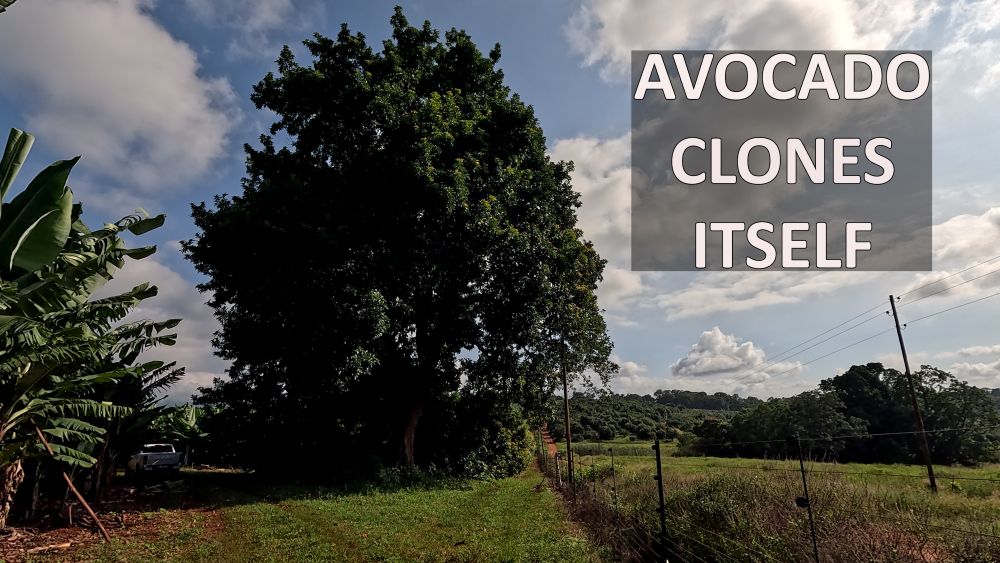Unlike many other fruit trees, avocados are hard to root. Rooting is where you cut a branch off a tree and stick it partly in the ground or a container so that the cut branch will form roots where it is buried. It’s a way of copying, or cloning, a tree. Try this with a fig or a pomegranate and you’ll likely succeed.
Not with avocados. Researchers have spent decades experimenting with avocado cuttings in order to get them to root more easily and reliably, but to this day the process remains comparatively difficult.
Keep this in mind as you encounter this tree:
It appears to root relatively easily, right?
But what exactly is the usefulness of such a tree? One, if its fruit is superb, then you could make copies of it to grow and share. Two, if the fruit is not superb, it has potential as a rootstock.
A cutting from this tree could be rooted, and then an avocado variety with a superior fruit could be grafted on top. Such a rootstock is called a clonal rootstock, as distinguished from one that has been grown from a seed. The advantage of a clonal rootstock is that it is a copy of the original tree and should grow just like the original tree whereas a seedling rootstock is always a little different, sometimes very different, from its parent (just like a human child is).
So imagine this: The tree above roots easily, making it faster and cheaper to turn into a clonal rootstock than most other avocado trees. Maybe it roots so easily that even you and I can get it to root at home. And then when used as a clonal rootstock, it turns out to grow a tough and productive tree with a grafted top that makes whatever fruit you like — Gwen, Fuerte, Reed, etc.
Such potential is why Stefan Koehne is stewarding this tree now. See my previous post on Stefan and “Stewarding avocado trees.”
Special thanks to Stefan Koehne for showing me this remarkable avocado tree.
Learn more about avocado rootstocks in my post here.
Learn a bit about the history and progression of rooting and cloning avocados in these articles:
(1937) “Rooting avocado cuttings,” by E.R. Eggers and F.F. Halma.
(1971) “Use of the etiolation technique in rooting avocado cuttings,” by E.F. Frolich and R.G. Platt.
(1999) “Micro cloning: a multiple cloning technique for avocados using micro containers,” by A.A. Ernst.
I can only keep the Yard Posts coming and ad-free through your support. Thanks!
Find all Yard Posts listed here.




Very interesting! I just buried two long stems of a GEM, known for its long “skirts,” leaving the leafing branch tops sticking out of the soil. In another development, a Mortgage Lifter tomato overwintered, is gigantic, blooming like crazy, and even has some small fruits underway. Most tomato plants don’t make it through the winter.
Hi Randy,
I look forward to hearing if the GEM branches root.
I moved into a house with an avocado tree in the backyard that doesn’t fruit. How can I tell if it’s too young or if it’s needs pollination? Or maybe something else? The tree is over 5ft tall
Can you tell if the tree is grafted? There will be a tell-tale ring or change in the trunk near the base where a productive stem was added. If grafted, it will produce fruit. Does it flower in the spring? It may take a few years to really produce.
If there is no sign of a graft, it is likely a plant grown from a seed. You might find remnants of the seed buried just below the soil surface. This tree is unlikely to produce edible fruit. But it can be used as root stock for a new graft. See Youtube for many videos on this.
In general, you don’t need to worry about pollination. Avo flowers are both male and female. Bees will take care of the rest.
Wow, what a beautiful tree, were you able to bring home any cuttings or fruit? The possibilities would be seemingly endless. Thanks for sharing that part of your journey.
So I came across an interesting sight today. I have a a small grove roughly about 90 trees. All my trees are on Zutano seedlings from what I know.
I’m getting ready to plant another 60 or so trees and recently started doing research on clonal rootstocks, and while I don’t have soil issues I’m interested in the production some clonals claim to offer.
I decided to visit a local nursery who claims they carry clonals. I wanted to see what they have to offer in stock and the vigor of those trees.
While inspecting tree trunks at the graft site and soil, I came across a Wurtz tree with a blue clonal rootstock tag that claimed to be on Dusa.
After further inspection I separated a dry avocado pit from the base of said avocado tree labeled to be on clonal Dusa rootstock.
If that tree was in fact on Dusa it would have been a Dusa seedling. It’s my understanding the seedling won’t give you the same uniform characteristics of its mother plant ( I see it on my own trees, they vary in size and vigor) .
To me that is not clonal because it doesn’t come directly from the original tree. Am I miss informed? I’d like to give the nursery the benefit of the doubt but the tree had been up potted to a 15 so I know they would have seen the pit when transplanted.
I came on here because I know Greg is extremely knowledgeable and was hoping for some insight.
Hi Frank,
This is curious. You are right about everything. There will be no seed at the base of the trunk on a clonal rootstock. The nurse seed that was grown before the clonal rootstock variety was grafted on will never be visible above the soil line, and it is sometimes completely removed from within the soil (depending on the propagation method).
A dry seed that is split and at the base of the tree indicates a seedling rootstock. I can imagine no other explanation.
Trees are mislabeled more frequently than nurseries want to admit. It’s hard not to ever make this mistake, and the best nurseries still get things mixed up from time to time.
I hope this is the case with this tree and not that the nursery is trying to deceive.
So how do I source rootstock avocado trees if I want to take a almost 50 year old tree with me when I move because I love the fruit it produces trying to clone grandpa’s tree before it’s too late! I’m in Los Angeles county and just have a backyard garden with a couple old trees
Hi Jennifer,
If you want to graft onto a tree in a container in order to later plant it, then the easiest thing to do is buy any avocado tree from a nursery to use as rootstock.
Alternatively, you can contact wholesale nurseries to buy ungrafted roostock trees, but they don’t often sell to individuals in small quantities.
Also, you can grow your own avocado sapling from a seed to use as rootstock.
You can also graft onto one of the old trees in your backyard.
There are many options to preserve your grandpa’s tree. Let me know if you need guidance with grafting, etc.